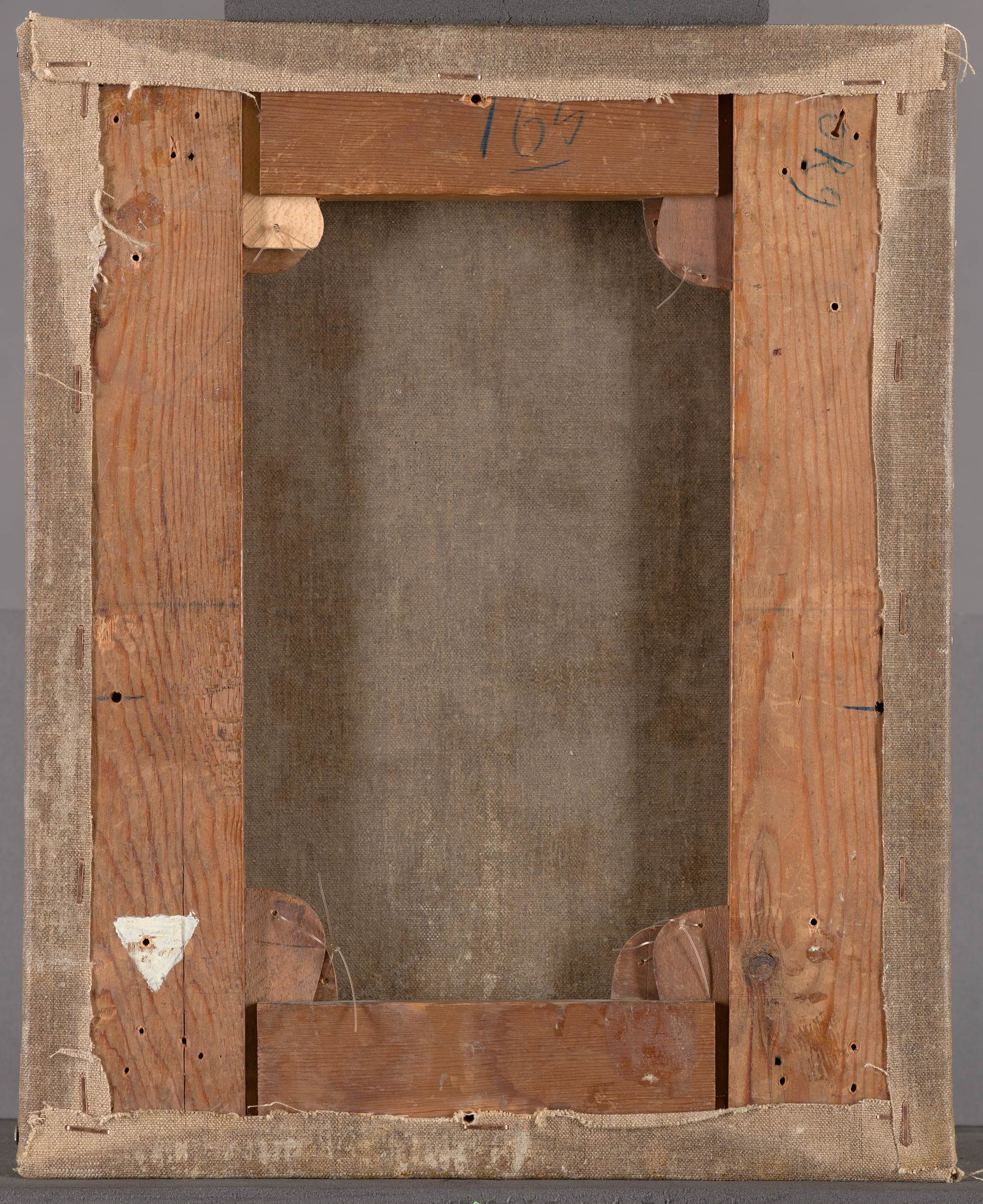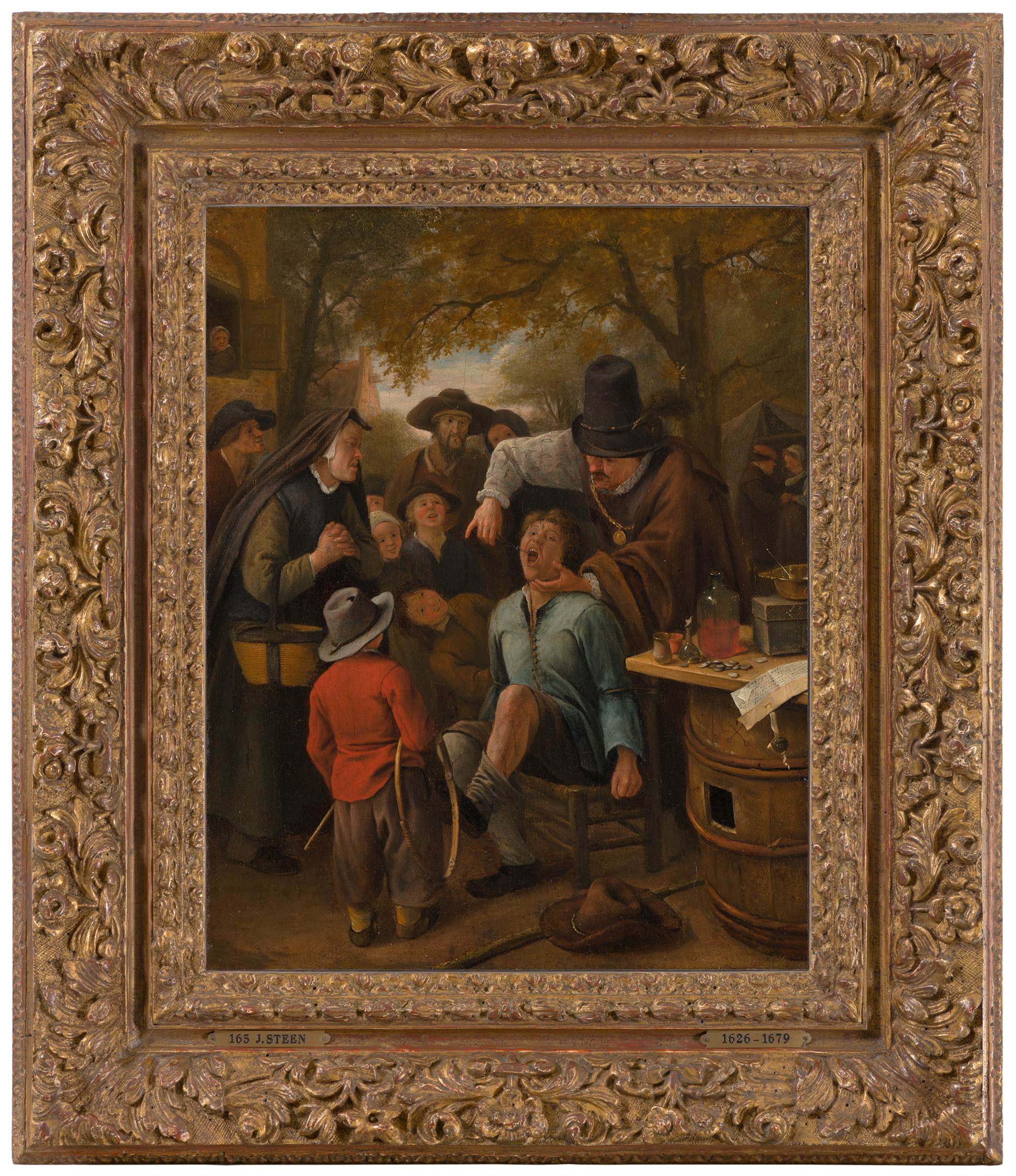No other seventeenth-century painter could ridicule human vice and folly as ingeniously and effectively as Jan Steen. In this relatively small work, a tooth-puller hoodwinks a gullible patient in front of a crowd of curious onlookers. The profession was held in very low regard at a time when dentistry was practised only by barber-surgeons and itinerant quacksalvers. Dim-witted peasants who let themselves be taken in by such untrustworthy characters were naturally the butt of jokes.1 The subject was clearly a rewarding one for Jan Steen, who seems to have discovered his talent for humour in this early painting. The composition is dated 1651 on the document lying on the table top at right.2 This is the first year from which dated work by Steen is known; on average, he dated one out of every ten works. While his earliest, undated peasant scenes testify to meticulous attention to the landscape setting, The Tooth-Puller is one of the first works in which he concentrated on the rendering of the figures. This particular painting evidently became renowned, as it appears on the painter’s easel together with a sketch of the patient’s face in Johannes Hari’s Household of Jan Steen of 1828 (Haarlem, Teylers Museum).3 A painting of such small format on a canvas support is extremely rare in Steen’s work; it may well have been painted on panel and transferred to canvas before 1816.4
The quacksalver also appears in Steen’s Village Fair (which was probably painted slightly earlier and is also in the Mauritshuis) but here demonstrating his skill together with a masked comedian and several musicians on a raised podium at right in the midst of a large commotion (see inv. no. 664). He holds up the tooth he has just extracted triumphantly, while the victim of his medical care stumbles down the steps of the podium with a cloth pressed to his aching cheek. In The Tooth-Puller Steen zooms in on the action. The patient, whose arms are tied to a low chair, looks at the viewer with his mouth wide open and his face contorted with fear and pain.5 His clenched fist and raised leg (with sagging stocking) express the tension of the moment. The quack has already gripped the tooth with his tongs and is about to yank it out. The curious little boy seen from the back with a hoop under his arm risks being kicked when the tooth is finally pulled. Like the other onlookers who have flocked to the scene, he stands as close as possible, so as not to miss any of the action. Laughing children mock the victim as he submits to the treatment of the sham surgeon, whose ludicrously old-fashioned clothing and pompous chain and medal of honour make it perfectly clear that he is not to be taken seriously. An old woman in a Northern Netherlandish huik (a long, hooded cloak without sleeves) seems genuinely concerned about the patient’s welfare and looks on worriedly, wringing her hands. Her wicker shopping basket and the sketchily rendered stall at back right identify the setting as a market, the workplace of itinerant quacksalvers.6
A plank laid on top of the empty beer barrel, which bears the crossed keys of Leiden’s coat of arms, serves as a table that displays the bogus doctor’s pots and jars.7 A brandywine bowl, used for mixing remedies, stands on the lid of a box.8 The most striking object is the meticulously rendered document with an official-looking wax seal, which hangs down over the edge of the plank. In addition to the year, 1651, it contains the inscription ‘Carolus Com[...]’: a certain count (Comes) Carolus apparently issued the certificate. Such pretentious documents are standard motifs in images of quacks and tooth-pullers, whose long iconographic tradition in Dutch and Flemish prints and paintings can be traced back to Hieronymus Bosch and Lucas van Leyden. The earliest depiction of a toothpuller in action occurs in Bosch’s Haywain of 1515 in the Prado in Madrid.9 This foreground figure, wearing a chain of pulled teeth around his neck, prominently exhibits an ‘official’ certificate of commendation on his work table. In Van Leyden’s Tooth-Puller, an influential print of 1523, the ostentatiously dressed mock doctor also has sealed documents on display.10 ‘The seal inspires confidence’ reads the motto of an emblem, accompanied by a print of a document with a wax seal, in Roemer Visscher’s emblem book Sinnepoppen of 1614.11 The fact that the tooth-puller needs such a document to gain the trust of his clients underlines his proverbial deceitfulness. According to a popular seventeenth-century saying, it was even possible to ‘lie like a tooth-puller’.12 The victim portrayed by Van Leyden is relieved not just of his tooth but also of his money, and his shabby clothing emphasises the stupidity that led to his being robbed by a charlatan. The simple, sometimes threadbare clothing of Steen’s characters, such as the hole in the hat of the boy with the hoop, also defines them as peasant folk.
Another depiction of a tooth-puller by Steen, presumably painted somewhat later, is situated in a barber shop, rather than a market. As in Van Leyden’s print, the patient is robbed by an accomplice of the ‘doctor’: the thief puts one hand in the victim’s egg basket (a traditional attribute of the peasant) and the other in his trouser pocket.13 Even the old woman bending solicitously over the patient is unaware of the theft. Such a naive onlooker – whether or not elderly – seems to have been a standard motif in representations of quacksalvers and also occurs repeatedly in the work of other artists.14 When the scene takes place at a market, she usually carries a shopping basket on her arm, as she does here; her hands are often clasped to express her concern for the patient. An early example of the use of this motif is a satirical, anti-Catholic print after the Antwerp master Marten van Cleve.15 In his scenes of quacks, Steen repeatedly depicted the improvised table of the tooth-puller ‘Meester Bonifaes’ – a plank lying on an empty beer barrel – as seen in the present painting. In a series of prints produced in the 1630s by Jan Both after his brother Andries, The Sense of Touch is appropriately portrayed by the torments of the tooth-puller. There, too, an old crone watching the spectacle anxiously wrings her hands.16 This worried hand-wringing is no coincidence, as evidenced by the inscription, which refers directly to the old woman: ‘Oh Fop, I wring my hands’ (‘Och Fop, ick wringh mijn handen’). Steen, who borrowed various motifs from these examples, seems to have studied them closely. For instance, the poses of the patient and the practitioner behind him in the Mauritshuis painting are based in part on the Both brothers’ print.17
In contrast to the reputation he acquired (mainly in the eighteenth century) for dissolute buffoonery, Steen was a wellgrounded artist who drew inspiration from a wide variety of sources and examples. In his younger years, Steen depended mainly on the work of Adriaen van Ostade, the Haarlem master of the peasant genre and one of Steen’s teachers, according to the artists’ biographer Jacob Campo Weyerman.18 In the case of the painting discussed here, Steen relied on the print after Andries Both, and, above all, on the example of Van Ostade’s Quacksalver of 1648 (Haarlem, Frans Hals Museum), an image that had also appeared in print. The most obvious case of borrowing is the little boy with the hoop. Steen repeatedly used this figure, seen from the back, with or without a hoop, as a means of leading the viewer’s eye into the picture.19 He also borrowed the setting and décor from Van Ostade: situating the scene under a tree and displaying the certificate and other objects on a makeshift table on top of an empty barrel. Van Ostade had also placed an old woman with a wicker basket among the crowd, but there she seems more like a passer-by. Unlike Van Ostade, who paid little attention to the humorous side of his subject matter and who left the actual subject matter somewhat ambiguous, Steen focused entirely on the quack’s treatment.
The quacksalver in all his guises was one of Steen’s favourite humorous subjects, and one for which he had a great affinity. He painted tooth-pullers, stone-cutters and barber-surgeons who cured credulous peasants of their (imaginary) aches and pains either in a ‘surgery’ or outdoors at the village market. Thematically speaking, these scenes are related to Steen’s later paintings of lovesick girls and their theatrically dressed ‘doctors’ in elegant interiors (see inv. nos. 167 and 168). The joke is the same – a blustering bore, pretending to be a doctor, who dupes naive patients – but the rustic locale was replaced by a more elegant setting. In the course of the 1650s, Steen increasingly distanced himself from the peasant genre by situating his narratives in a more prosperous bourgeois milieu, without neglecting the humorous side of the subject. Even so, he continued to pay attention to peasant satire throughout his career, and he frequently revisited the subject of the rustic quacksalver, a minority of which were toothpullers.20 It is difficult to establish a chronology for these works in Steen’s oeuvre, because the only dated work is the Tooth-Puller discussed here. A Stone-Cutter (Rotterdam, Museum Boijmans Van Beuningen), related in both subject and composition to the present painting, stems from the 1660s at the earliest, as shown by dendrochronological examination of the panel.21 It depicts a quacksalver removing from the head of an ignorant peasant a stone (and thus his lunacy) in the midst of laughing spectators.
This Tooth-Puller of 1651 provides an important basis for determining the chronology of Steen’s oeuvre. Steen demonstrated his ability to paint in an extremely refined and detailed manner in this early work. He draws attention to such details as the certificate on the table and the face of the young patient at the heart of the composition by working them out carefully with a fine brush. Other passages, such as the figures in the background, are much more sketchily rendered; this method serves to direct the viewer’s gaze to certain details. This varied technique became Steen’s trademark.










